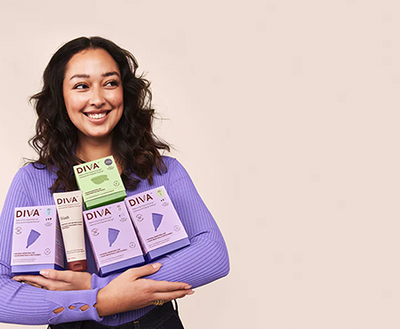

A diet rich in vegetables, fruits and protein can supply many of nutrients for healthy hormones. Sometimes, however, we may benefit from extra support in the form of supplementation to meet those recommended daily values.
Here, we share how key vitamins and minerals support reproductive health, how they can ease period and PMS symptoms, and which ones to focus on for healthy hormones.
What nutrients and vitamins balance hormones for females?
Nutrients affect the function of the body’s endocrine system—our hormones use these nutrients to run smoothly. A healthy menstrual cycle is driven by the fluctuations of the reproductive hormones, including follicle stimulating hormone (FSH), luteinizing hormone (LH), estrogen and progesterone. Our reproductive hormones act as chemical messengers.Certain nutrients can help keep estrogen levels optimal, for example, as well as affect the ability of hormone receptors to pick up the signals coming from these hormones, setting certain processes—like a menstrual cycle—in motion. Hormone imbalances may disrupt these processes.
Getting enough nutrients is key. Not getting enough can accelerate ovarian aging, affect egg quality, shorten your cycle length or delay ovulation—all things that affect reproductive and overall health.
Important Nutrients for Healthy Hormones and Reproductive Health
1. Vitamin D
Vitamin D plays a crucial role in our health and hormone function—but many of us are deficient in North America—due to many months of decreased sunlight. It affects immune function and gene expression, and may help protect against diabetes, cancer, cardiovascular health—to name just a few.When it comes to reproductive health, vitamin D affects the sensitivity of the follicle cells to hormones like FSH, which is vital to egg growth, ovulation and the overall functioning of the menstrual cycle. Low vitamin D has been linked to delayed ovulation and long-than-normal cycles, as well as menstrual disorders, like endometriosis and fibroids.
Vitamin D has been shown to reduce menstrual pain by decreasing inflammation and can also help with our mental health, potentially reducing PMS-related moodiness.
2. Magnesium
Magnesium is a co-factor in more than 300 enzyme systems in the body, including liver and thyroid function. It helps to manage our brain function and mood, while decreasing muscle tension.
Although you can find it in many whole grains, nuts and seeds, almost half of the American population is still deficient. When it comes to your cycle, magnesium may help decrease premenstrual anxiety as well as menstrual pain and works especially well when paired with vitamin D and calcium.
3. Omega-3 Fatty Acids
Omega-3s plays a large role in the structure and function of our cell membranes, in addition to being potent anti-inflammatories. They serve as the backbone for making hormones like estrogen, testosterone, progesterone and cortisol.
When it comes to reproductive health, consuming omega-3s can keep your cycle regular (by improving ovulation rates), ensure proper menstrual flow (by improving progesterone levels), can decrease menstrual pain, can and improve egg quality (by maintaining healthy cell activity).
Essential fatty acids (EFAs), like omega-3s, are essential because we can’t make them on our own—they come exclusively from diet and supplementation. Foods rich in omega-3 include eggs, fish like sardines, mackerel and salmon, as well as various nuts and seeds including flaxseeds.
4. Zinc
Zinc ensures our cells can grow and divide properly, is required to make DNA, and is needed for the proper function of both our reproductive and immune systems. Zinc also an antioxidant, protecting our cells and their DNA from free radical damage. Zinc also supports ovulation, contributes to FSH and LH production, and supports insulin sensitivity—all important reproductive functions.
It can help reduce period-related fatigue, mood swings and pain. You can find zinc in many animal products, making it a key supplement for vegans and vegetarians, who may not be getting as much from their diets.
5. B Vitamins
B Vitamins support nervous system function. Being low in vitamin B can contribute to fatigue, anxiety, depression. Vitamin B6 may be helpful in decreasing mood symptoms of PMS, as well as premenstrual depression.
B vitamins also support egg quality and the function of the ovaries and uterus. Focus on including B6, B12 and folic acid to support healthy hormones.
There may be gaps in your regular diet that supplements can help with. When paired with a healthy lifestyle, supplements can ensure you're getting what you need to help with balanced hormones and regular cycles.
Bird&Be’s The Essentials for Females was formulated by doctors and the once-a-day supplement sachets are full of high-quality, bioavailable ingredients to help support your reproductive health, when paired with a healthy lifestyle. Always consult your healthcare provider before introducing anything new into your healthcare routine.






















